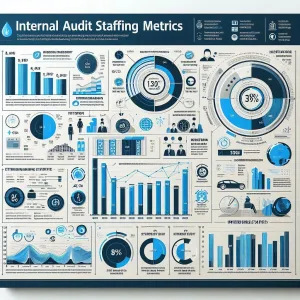In today’s rapidly evolving business landscape, digital transformation has become a critical focus for organizations aiming to enhance efficiency, improve decision-making, and maintain compliance. In the context of internal audit, digital transformation, including tools like Workiva vs AuditBoard, refers to the integration of advanced technologies and innovative practices that streamline audit processes, enhance data analytics, and foster real-time collaboration. This shift not only optimizes the audit function but also aligns it more closely with organizational goals, enabling audit teams to provide valuable insights and support strategic initiatives.
As organizations navigate this digital landscape, two platforms have emerged as frontrunners in the realm of audit management: Workiva and AuditBoard. Both solutions offer robust features designed to facilitate the internal audit process, but they cater to different needs and preferences. Workiva is known for its comprehensive approach to compliance and reporting, while AuditBoard excels in automating key audit processes and enhancing collaboration among teams.
For CIOs and technology leaders, selecting the right tools is paramount. The choice between Workiva and AuditBoard can significantly impact the effectiveness of the internal audit function, influencing everything from risk management to stakeholder communication. As these leaders embark on their digital transformation journeys, understanding the strengths and capabilities of each platform will be essential in making informed decisions that drive organizational success.
Understanding Workiva
Workiva has established itself as a leading platform in the realm of internal audit, particularly as organizations increasingly embrace digital transformation. The evolution of Workiva has been marked by its commitment to enhancing the efficiency and effectiveness of audit processes through innovative technology solutions.
Evolution and Market Positioning
Originally designed to streamline financial reporting, Workiva has expanded its capabilities to encompass a broader range of functions, including internal audit management. This evolution has positioned Workiva as a vital tool for organizations looking to integrate their audit processes with other business functions, thereby enhancing overall operational efficiency. The platform’s ability to adapt to the changing landscape of technology and regulatory requirements has solidified its reputation in the market as a reliable partner for internal audit teams.
Key Features Relevant to Internal Audit
Workiva offers a suite of features that are particularly beneficial for internal audit functions:
- Data Integration: Workiva allows for seamless integration of data from various sources, enabling auditors to access and analyze information in real-time. This capability is crucial for maintaining accuracy and consistency in audit reporting, as it reduces the risk of errors associated with manual data entry and disparate systems [10].
- Real-Time Reporting: The platform provides powerful dashboards and user-centric reports that offer real-time insights into the status of audit engagements. This feature enhances transparency and allows audit teams to make informed decisions quickly, thereby improving the overall audit process.
- Collaboration Tools: Workiva fosters collaboration among audit team members and stakeholders through its intuitive interface. The platform enables users to link data and commentary, creating a more comprehensive narrative of the audit findings. This collaborative approach not only enhances communication but also ensures that all relevant parties are aligned throughout the audit process [11].
Enabling Digital Transformation in Audit Processes
Workiva’s technology is designed to facilitate digital transformation within internal audit functions. By centralizing financial reporting, ESG reporting, audit, and risk management, Workiva provides a unified platform that reduces the complexity of managing multiple applications. This centralization not only saves time but also minimizes risks associated with data handling and reporting [12].
Moreover, the introduction of features like Audit Analytics enhances the platform’s capability to support data-driven decision-making. This integration strengthens risk assurance and improves efficiency, allowing audit teams to focus on strategic insights rather than getting bogged down by manual processes [15].
In summary, Workiva stands out as a robust solution for internal audit functions, offering essential features that support digital transformation. Its ability to integrate data, provide real-time reporting, and enhance collaboration positions it as a key player in the future of internal audit, making it an attractive option for CIOs and technology leaders looking to modernize their audit processes.
Exploring AuditBoard
AuditBoard has established itself as a leading cloud-based platform dedicated to transforming audit management, risk management, and compliance functions within organizations. With a strong emphasis on enhancing the internal audit process, AuditBoard is designed to meet the evolving needs of businesses in an increasingly digital landscape.
Background of AuditBoard
Founded with the mission to streamline and modernize internal audit processes, AuditBoard has quickly become a trusted solution for many organizations, including over 50% of the Fortune 500. The platform is recognized for its comprehensive approach to Governance, Risk, and Compliance (GRC), providing tools that facilitate efficient collaboration and automate workflows. This focus on innovation positions AuditBoard as a key player in the digital transformation of internal audit functions, enabling organizations to adapt to new challenges and opportunities in the business environment [5][10].
Critical Features
AuditBoard offers a suite of critical features that enhance the effectiveness of internal audit processes:
- Risk Management: The platform provides robust risk management tools that allow organizations to identify, assess, and mitigate risks effectively. This proactive approach helps ensure that potential issues are addressed before they escalate, thereby safeguarding the organization’s assets and reputation [10][12].
- Compliance Tracking: AuditBoard includes comprehensive compliance tracking capabilities, which are essential for organizations to meet regulatory requirements. The software enables users to manage policies and compliance activities efficiently, ensuring that all necessary documentation is in place and up to date [7].
- Automation Capabilities: One of the standout features of AuditBoard is its automation functionality. By automating repetitive and manual processes, the platform significantly reduces the complexity and time associated with audit tasks. This not only enhances productivity but also allows internal audit teams to focus on more strategic initiatives [13][15].
Supporting Digital Transformation
As organizations embark on their digital transformation journeys, AuditBoard plays a crucial role in facilitating this transition. The platform’s cloud-based architecture allows for seamless integration with existing systems, enabling organizations to leverage their data more effectively. By providing a centralized and integrated platform, AuditBoard enhances collaboration among audit, risk, and compliance teams, fostering a culture of transparency and accountability [10][15].
Moreover, the adoption of AuditBoard aligns with the growing trend of digital transformation in internal audit functions. As organizations increasingly recognize the importance of technology in driving efficiency and effectiveness, AuditBoard stands out as a must-have solution for those looking to modernize their audit processes and achieve greater clarity and agility in their operations [11][12].
In summary, AuditBoard is not just a tool for managing audits; it is a comprehensive solution that empowers organizations to navigate the complexities of modern business while embracing the digital advancements that are reshaping the internal audit landscape.
Comparative Analysis: Workiva vs. AuditBoard
In the rapidly evolving landscape of internal audit, the choice between Workiva and AuditBoard is pivotal for CIOs and technology leaders aiming to leverage digital transformation. This section provides a detailed comparison of both platforms, focusing on their user interface, integration capabilities, pricing models, and real-world applications.
User Interface and User Experience
- Workiva: Users have reported that Workiva offers a straightforward setup process, which is particularly beneficial for organizations looking to implement audit solutions quickly. The platform is designed with user-friendliness in mind, making it accessible for teams with varying levels of technical expertise. However, some users have noted that while the interface is easy to navigate, it may lack advanced customization options that could enhance user experience further [11].
- AuditBoard: In contrast, AuditBoard is praised for its intuitive user interface, which facilitates a seamless experience for internal audit teams. Reviewers have highlighted that AuditBoard is easier to use overall, which can lead to increased productivity and efficiency in audit processes. The platform also provides robust features that cater specifically to audit management, compliance, and risk management, making it a strong contender in terms of user experience [15].
Integration Capabilities
- Workiva: This platform excels in its integration capabilities, allowing for smooth connections with various enterprise systems. Workiva’s ability to integrate with existing tools and data sources is a significant advantage for organizations looking to streamline their audit processes and enhance data accuracy. This flexibility is crucial for CIOs who need to ensure that their audit solutions work harmoniously within their broader technology ecosystem [12][15].
- AuditBoard: While AuditBoard also offers integration options, it is essential to evaluate how well these integrations align with specific organizational needs. AuditBoard’s focus on audit management means that it may not integrate as seamlessly with non-audit systems compared to Workiva. However, it does provide essential functionalities that support compliance and risk management, which can be beneficial for organizations prioritizing these areas [14].
Pricing Models and Value Proposition
- Workiva: The pricing model for Workiva is generally perceived as competitive, especially considering the breadth of features it offers. For technology leaders, the overall value proposition lies in its comprehensive capabilities that support not only internal audits but also broader governance, risk, and compliance (GRC) needs. This makes Workiva a versatile choice for organizations looking to invest in a multi-functional platform [11][12].
- AuditBoard: AuditBoard’s pricing may vary based on the specific features and functionalities selected. While it is often viewed as a cost-effective solution for organizations focused primarily on audit management, CIOs should consider the potential need for additional investments in integrations or customizations. The value proposition for AuditBoard is strong in its specialized focus on internal audit processes, which can lead to enhanced efficiency and effectiveness in audit functions [14].
Both Workiva and AuditBoard present compelling options for organizations navigating the digital transformation of internal audit. While Workiva shines in integration capabilities and overall versatility, AuditBoard offers a user-friendly experience tailored specifically for audit management. CIOs and technology leaders must weigh these factors against their organizational needs to make an informed decision that aligns with their digital transformation goals.
Adapting to Digital Advancements
In the rapidly evolving landscape of internal audit, platforms like Workiva and AuditBoard are at the forefront of digital transformation. As organizations increasingly rely on technology to enhance their audit processes, understanding how these platforms adapt to digital advancements is crucial for CIOs and technology leaders. Here, we explore the integration of AI and machine learning, compliance adaptations, and features that facilitate remote auditing and collaboration.
Role of AI and Machine Learning in Enhancing Audit Processes
Both Workiva and AuditBoard leverage AI and machine learning to streamline and enhance audit processes. These technologies enable:
- Automation of Routine Tasks: By automating repetitive tasks, both platforms allow audit teams to focus on more strategic activities. This not only increases efficiency but also reduces the risk of human error, leading to more accurate audit outcomes.
- Data Analytics: Advanced analytics capabilities help auditors identify trends and anomalies in large datasets, providing deeper insights into organizational risks and controls. This proactive approach to risk management is essential in today’s data-driven environment [4].
- Predictive Insights: Machine learning algorithms can analyze historical data to predict potential compliance issues or areas of concern, allowing organizations to address risks before they escalate.
Adapting to Regulatory Changes and Compliance Needs
As regulatory landscapes continue to evolve, both Workiva and AuditBoard are committed to ensuring their platforms remain compliant and adaptable:
- Real-Time Compliance Monitoring: Workiva offers features that allow organizations to monitor compliance in real-time, ensuring that they can quickly adapt to new regulations as they arise. This capability is crucial for maintaining compliance in a dynamic regulatory environment [10].
- Customizable Frameworks: AuditBoard provides customizable control frameworks that can be tailored to meet specific regulatory requirements. This flexibility allows organizations to stay ahead of compliance needs without extensive reconfiguration of their audit processes [12].
- Integration with Regulatory Updates: Both platforms are designed to integrate updates related to regulatory changes seamlessly, ensuring that users have access to the latest compliance requirements and best practices [11].
Features Supporting Remote Auditing and Virtual Collaboration
The shift towards remote work has necessitated robust solutions for virtual collaboration in internal audit. Workiva and AuditBoard have developed features that support this transition:
- Cloud-Based Solutions: Both platforms operate on cloud-based infrastructures, enabling auditors to access necessary tools and data from anywhere. This flexibility is essential for teams working remotely or in hybrid environments [14].
- Collaboration Tools: Workiva includes built-in communication features that facilitate collaboration among team members without relying on external tools. This integrated approach enhances efficiency and ensures that all team members are aligned on audit objectives.
- Document Management: AuditBoard offers comprehensive document management capabilities, allowing teams to share and collaborate on audit documentation in real-time. This feature is particularly beneficial for maintaining transparency and accountability during remote audits [12].
As digital transformation continues to reshape the internal audit landscape, both Workiva and AuditBoard are evolving to meet the demands of technology leaders. By harnessing AI and machine learning, adapting to regulatory changes, and supporting remote collaboration, these platforms are not only enhancing audit processes but also positioning themselves as leaders in the future of internal audit.
Future Trends in Internal Audit Technology
As the landscape of internal audit continues to evolve, driven by rapid technological advancements, CIOs and technology leaders must stay informed about emerging trends that can significantly impact their organizations. Two prominent platforms in this space, Workiva and AuditBoard, are adapting to these changes in distinct ways. Here, we explore key trends such as predictive analytics, blockchain, and continuous auditing, and examine how both platforms are positioning themselves for the future.
Key Trends in Internal Audit Technology
- Predictive Analytics: This technology enables auditors to analyze historical data to forecast future risks and trends. By leveraging predictive analytics, organizations can proactively address potential issues before they escalate. Both Workiva and AuditBoard are integrating advanced analytics capabilities into their platforms, allowing auditors to gain deeper insights and make data-driven decisions.
- Blockchain: The adoption of blockchain technology in internal audit processes is gaining traction due to its ability to enhance transparency and security. Blockchain can provide a tamper-proof record of transactions, making it easier for auditors to verify data integrity. Workiva and AuditBoard are exploring ways to incorporate blockchain into their solutions, which could revolutionize how audits are conducted and reported.
- Continuous Auditing: This approach allows for real-time monitoring of transactions and controls, enabling organizations to identify and mitigate risks more effectively. Continuous auditing shifts the focus from periodic reviews to ongoing assessments, which can lead to improved compliance and risk management. Both platforms are enhancing their capabilities to support continuous auditing, ensuring that organizations can maintain a high level of oversight.
Positioning for the Future
- Workiva: Known for its robust data integration and collaboration features, Workiva is focusing on enhancing its platform to support the evolving needs of internal auditors. The company is investing in AI and machine learning to automate routine tasks, allowing auditors to concentrate on more strategic activities. Workiva’s commitment to providing a seamless user experience and real-time data access positions it well for the future of internal audit.
- AuditBoard: AuditBoard is also making significant strides in adapting to digital transformation. The platform emphasizes user-friendly interfaces and powerful analytics tools that empower auditors to conduct thorough assessments efficiently. AuditBoard is actively developing features that facilitate continuous auditing and risk management, ensuring that organizations can respond swiftly to emerging challenges.
Encouragement for CIOs and Technology Leaders
As the internal audit landscape continues to transform, it is crucial for CIOs and technology leaders to remain vigilant about technological advancements. By understanding and embracing trends such as predictive analytics, blockchain, and continuous auditing, organizations can enhance their audit processes and drive greater value. Both Workiva and AuditBoard are leading the charge in this digital transformation, and their ongoing innovations will play a pivotal role in shaping the future of internal audit.
Staying informed about these emerging trends and the strategies employed by leading platforms will empower CIOs and technology leaders to make informed decisions that align with their organization’s goals and enhance their internal audit functions.
Conclusion
In the rapidly evolving landscape of internal audit, the choice between Workiva and AuditBoard is pivotal for organizations aiming to leverage digital transformation effectively. As technology leaders and CIOs navigate this transition, it is essential to recognize the significance of selecting the right audit technology that aligns with their strategic objectives.
- Importance of Choosing the Right Audit Technology: In an era where digital advancements are reshaping business processes, the right audit technology can enhance efficiency, improve compliance, and foster collaboration across teams. Both Workiva and AuditBoard offer unique features that cater to different organizational needs, making it crucial for leaders to assess which platform best supports their internal audit functions and overall governance, risk, and compliance (GRC) strategies [1][5].
- Strategic Evaluation of Workiva and AuditBoard: Organizations should conduct a thorough evaluation of both platforms, considering factors such as user experience, scalability, and specific functionalities that address their internal audit requirements. Workiva is recognized for its strong capabilities in financial and regulatory filing, while AuditBoard excels in providing pre-built frameworks for compliance in regulated industries. Understanding these distinctions can help organizations make informed decisions that align with their operational goals [2][3][6].
- Engagement and Discussion: We encourage readers to share their experiences and preferences regarding Workiva and AuditBoard. Engaging in discussions can provide valuable insights into how these platforms are being utilized in various organizational contexts and can help peers learn from one another’s successes and challenges. By fostering a community dialogue, technology leaders can better navigate the complexities of digital transformation in internal audit [9][10].
In conclusion, as organizations embark on their digital transformation journeys, the choice between Workiva and AuditBoard will significantly impact their internal audit effectiveness. By carefully evaluating their options and engaging with peers, CIOs and technology leaders can position their organizations for success in this dynamic environment.
Find out more about Shaun Stoltz https://www.shaunstoltz.com/about/
This post was written by an AI and reviewed/edited by a human.



